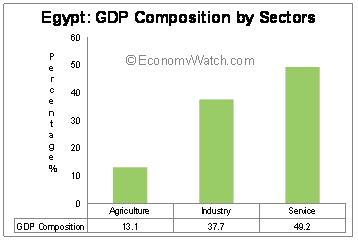Egypt Economic Structure
Please note that we are not authorised to provide any investment advice. The content on this page is for information purposes only.
Egypt’s economic structure was highly centralized until the late 20th century. In the 1990s, the International Monetary Fund (IMF) pushed the government for economic reforms in strategic sectors. Since then, the country has opened up its economy to foreign and private investment.
Egypt’s economic structure was highly centralized until the late 20th century. In the 1990s, the International Monetary Fund (IMF) pushed the government for economic reforms in strategic sectors. Since then, the country has opened up its economy to foreign and private investment.
Egypt is a recipient of vast amounts of military and financial aid, the military remains both the country’s main social and primary economic force. Similiar to past scenarios in Indonesia and Turkey, the Egyptian military owns many commercial companies and has monopolies on industries such as water, olives and construction.
Table of Contents
Egypt Economic Structure: GDP Composition
Egypt’s economic structure is one of the most developed and diversified among the African and Middle East countries. It has a large industry sector, an essential primary sector and a fast evolving service sector.
Agriculture used to be the mainstay for the Egyptian economy. However, with rapid industrialization, its share has been reduced to 13.1 percent of GDP in 2010. In the 1970s, agriculture used to employ more than 90 percent of the Egyptian working population. Today, it only employs 32 percent of the labor force.
The industrial sector employs approximately 17 percent of the labor force and contributes 37 percent of GDP. Egypt has a range of industries, such as steel, electricity, oil extraction and refinery, chemicals, domestic goods and automobiles. The IT industry is also gradually expanding in the region.
The service sector is the largest contributor to the Egyptian economy, with a contribution in excess of 49 percent. Also, it offers employment to almost 50 percent of the population. The major service sector areas are construction, tourism, canal trade and administrative jobs.

Egypt Economic Structure: Business Climate
Until 2003, Egypt’s economic structure was hostile towards foreign investment. The economy suffered from high interest rates and tariff barriers. However, a series of economic reforms were introduced in 2005 to address these issues. Major tax cuts and trade tariff cuts enabled the economy to open up to foreign direct investment (FDI). These proactive steps from the government helped restore investor trust and confidence in Egypt’s economy. Egypt’s FDI reached $66.43 billion in 2010, up from $59.13 billion in 2008.
The Cairo & Alexandria Stock Exchange was recently ranked among the world’s top ten evolving markets.
Egypt’s Economic Geography
Location: Northern Africa, bordering the Mediterranean Sea, between Libya and the Gaza Strip, and the Red Sea north of Sudan, and includes the Asian Sinai Peninsula. Egypt controls the Sinai Peninsula, the only land bridge between Africa and remainder of the Eastern Hemisphere.
It also the controls the Suez Canal, a sea link between Indian Ocean and Mediterranean Sea.
Its size, and juxtaposition to Israel means Egypt has a major role in Middle Eastern geopolitics. It has dependence on upstream neighbors but dominates Nile basin issues, and is prone to influxes of refugees.
Area: total: 1,001,450 sq km land: 995,450 sq km water: 6,000 sq km
Terrain: vast desert plateau interrupted by Nile valley and delta, with only about 3% of land suitable for farming.
Land boundaries: total: 2,665 km border countries: Gaza Strip 11 km, Israel 266 km, Libya 1,115 km, Sudan 1,273 km
Coastline: 2,450 km
Natural hazards: prone to periodic droughts; frequent earthquakes; flash floods; landslides; hot, driving windstorm called khamsin occurs in spring; dust storms and sandstorms.
Natural resources: petroleum, natural gas, iron ore, phosphates, manganese, limestone, gypsum, talc, asbestos, lead, zinc
Agriculture products: cotton, rice, corn, wheat, beans, fruits, vegetables; cattle, water buffalo, sheep, goats
Egyptian Population and Labor Force
Egypt’s population in 2010 was 78.238 million. Over 31 percent of the population is aged 14 years and under, and over 40 percent are aged 20 and under. The median age in Egypt is 24, and only 5 percent of the population is aged 65 and over.
Like many Arab countries, Egypt has a young economy, growing fast and at a rate of 5.3 percent in 2010; however the nation struggles with rife unemployment and the flow-on social problems that arise when employment opportunities are few and limited in a youthful population.
The workforce is already at 25.8 million as of 2010, with thousands of students graduating every day and joining the workforce – or pool of unemployed. The most recent estimate for unemployment in Egypt is 9.7 percent, and with the current uncertainty and disruption caused by the uprising, that figure has probably risen to over 10 percent.
Recent 2010 data shows 32 percent of the labour force is employed in agriculture, 17 percent in industry and 51 percent in services.
Around half of the population live below the poverty line.




